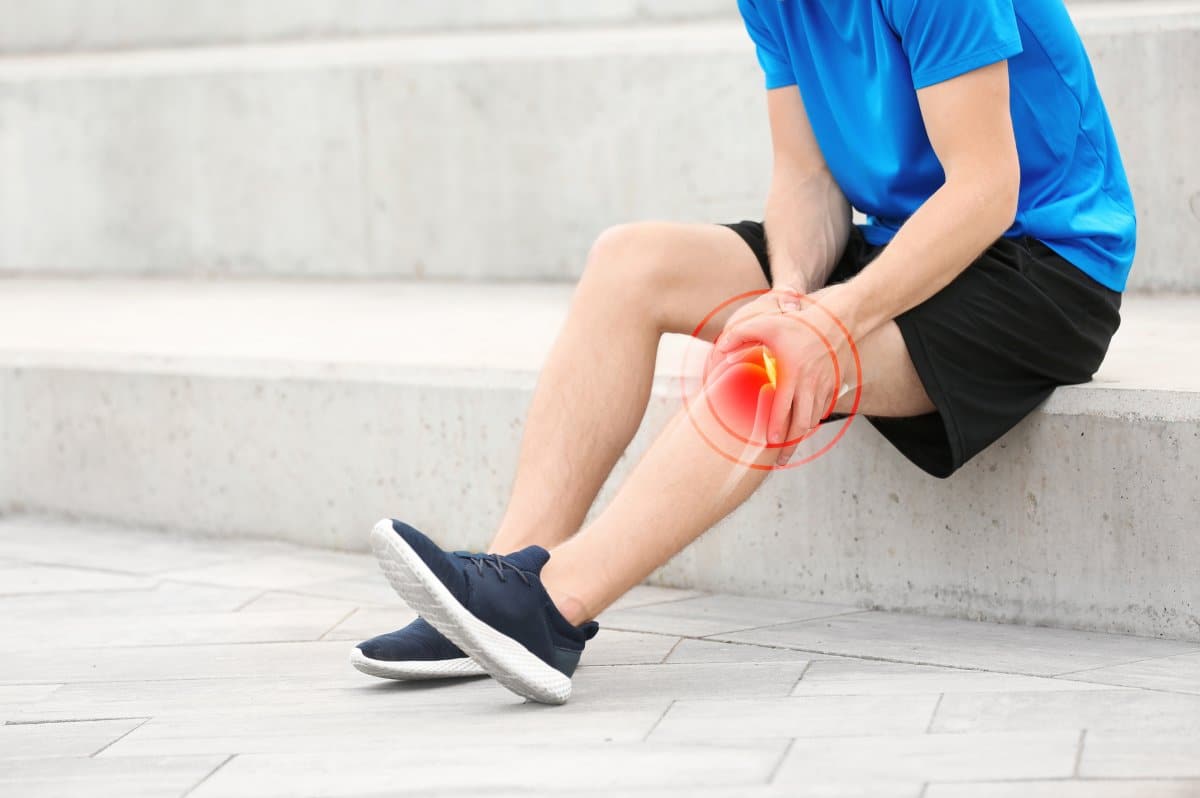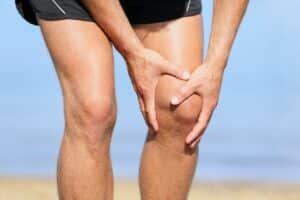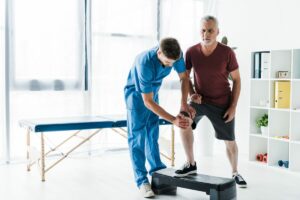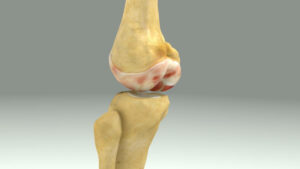Free download: Top 10 Natural & Easy Remedies for Joint Pain from Home. Learn these helpful remedies.
While climbing stairs is a very normal activity, it’s one that can unfortunately lead to knee pain all too often. This pain can occur both going up or down stairs, but going down stairs seems to be the most common occurrence.
Why is this?
There are many reasons behind knee pain when going down stairs. It’s important to identify what these possible causes of knee pain are in order to effectively treat it and stop your pain.
Table of Contents
Knee Anatomy and Knee Pain
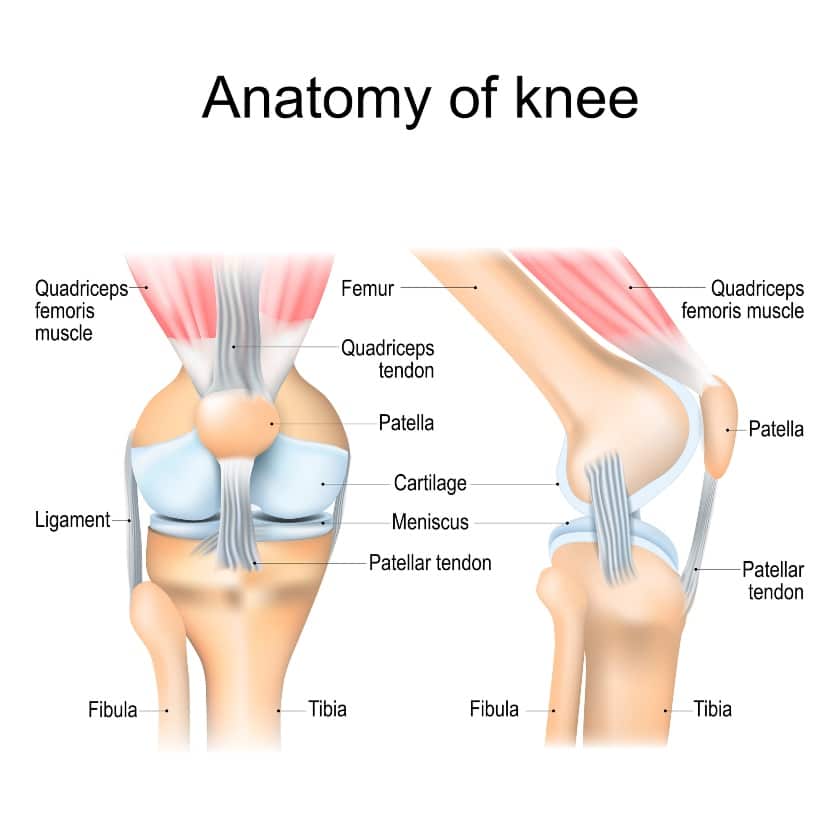
While there is a lot of detail surrounding the knee anatomy, we’ll be talking about the basics to get a better understanding as to what structures could be causing knee pain when going down stairs.
The knee consists of 3 knee bones:
- Femur, or thigh bone
- Tibia, or shin bone
- Patella, or knee cap
Technically, 2 joints make up the knee:
- Tibiofemoral joint
- Patellofemoral joint
The knee is a hinge joint, which primarily allows for the motions of flexion and extension, or bending and straightening the knee, respectively. There is also slight internal and external rotation available at the knee.
Multiple soft tissue structures surround and are located within the knee to provide support, stability, cushioning and shock absorption during movement. For a brief overview, common and most well-known soft tissue structures in and around the knee include the following:
- Knee articular cartilage
- Medial and lateral meniscus
- 4 primary ligaments (2 cruciate ligaments and 2 collateral ligaments)
- Anterior cruciate ligament (ACL)
- Posterior cruciate ligament (PCL)
- Medial collateral ligament (MCL)
- Lateral collateral ligament (LCL)
- Various muscles and tendon attachments to the knee:
- Quadriceps
- Hamstrings
- Calf muscles
- Patellar tendon (a.k.a. patellar ligament)
- Other soft tissue structures that can contribute to knee pain if not addressed include the following:
- Synovial membrane
- Knee plica
- Knee bursae sacs
- Iliotibial band
Wear and tear or injury in any of the above structures can lead to knee pain.
Causes of Knee Pain When Going Down Stairs
Now that we know a little more about the basics of knee anatomy, let’s take a look at the most common possible causes of knee pain, which can then lead to knee pain when going down stairs.
1. Knee Arthritis

Various types and forms of arthritis exist. Arthritis will typically lead to break down and inflammation of the structures within the joint (e.g., cartilage, synovial membrane, menisci), creating pain as a result.
The most common types of arthritis include the following:
- Knee osteoarthritis
- Rheumatoid arthritis
- Gout
- Psoriatic arthritis
Knee osteoarthritis is the most common type of arthritis that occurs in the knee and is due to progressive wear and tear in the joint. These degenerative changes will usually build up over time, and eventually lead to joint pain in the knee.
2. Knee Ligament Injury
Ligaments play a large role in keeping the knee stable, so injury to any of the ligaments can be very devastating, causing pain and instability in the knee.
Ligament injuries can range in severity from a minor sprain to a partial ligament tear or may be a more serious knee injury such as a complete ligament tear or rupture.
An ACL tear is one of the most common ligament injuries that athletes in particular will face.
The severity of the tear and its effects on functional mobility and pain will determine how the knee can be treated (e.g., rehabilitation with or without surgical intervention).
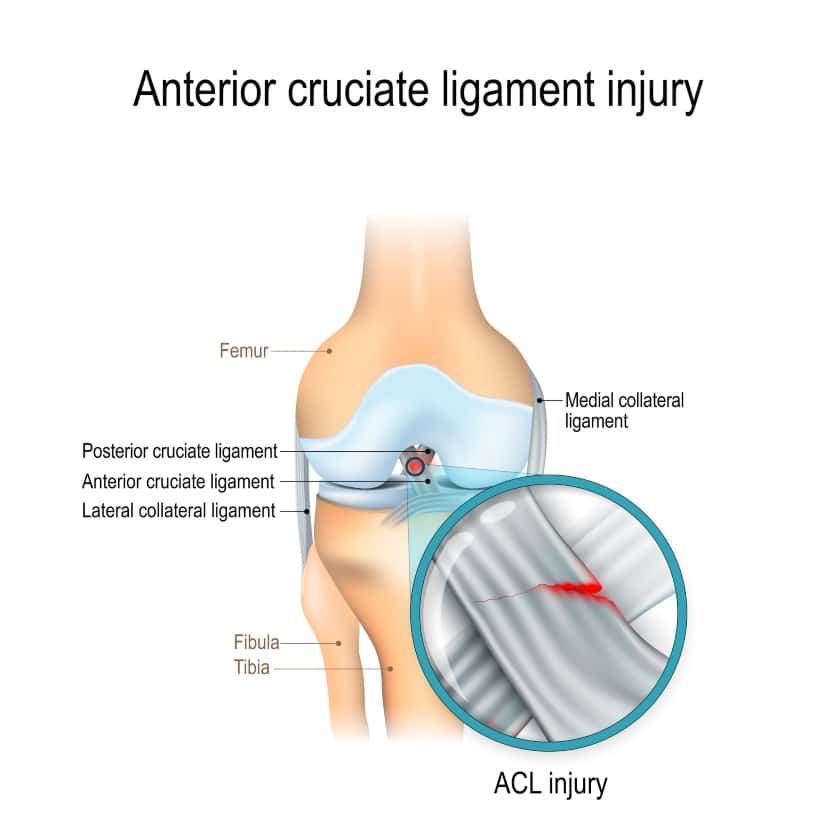
3. Muscle or Tendon Injury
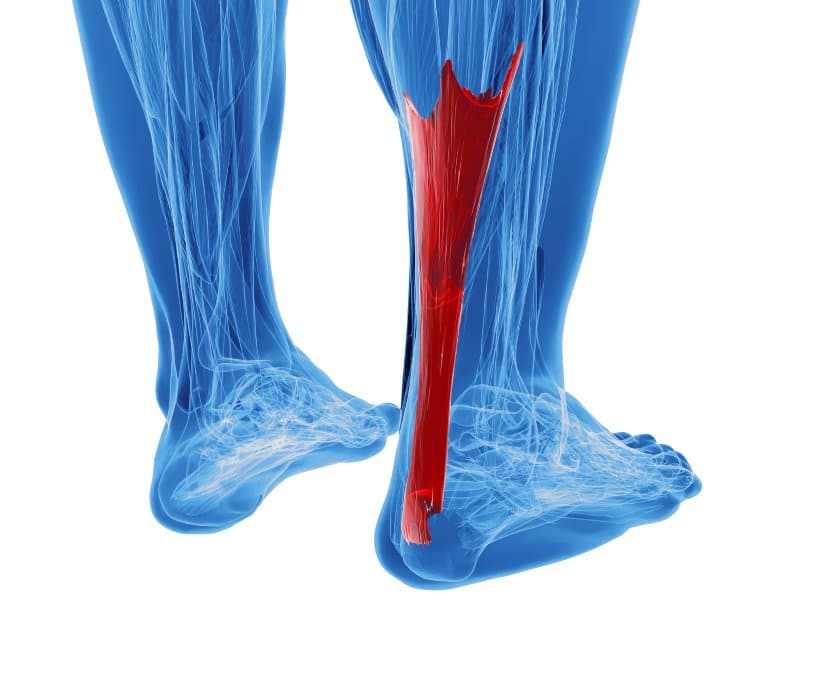
Muscle imbalance and major or minor muscle injuries can contribute to knee pain.
A muscle and its tendon attachment has the potential to experience a strain or tear as a result of injury, such as from a sports injury.
A muscle imbalance can be the result of muscle weakness and/or muscle tightness. These imbalances can affect the load and tension on the attaching tendons, which connect to the knee. These altered forces can place unnecessary stress and strain on the joint, leading to knee pain.
Tendons alone can also experience pain and inflammation from tendonitis. A common example of this is patellar tendonitis. This typically occurs as a result from an overuse injury, typically from repetitive knee bending activities such as climbing stairs, running, and biking.
4. Knee Bursitis
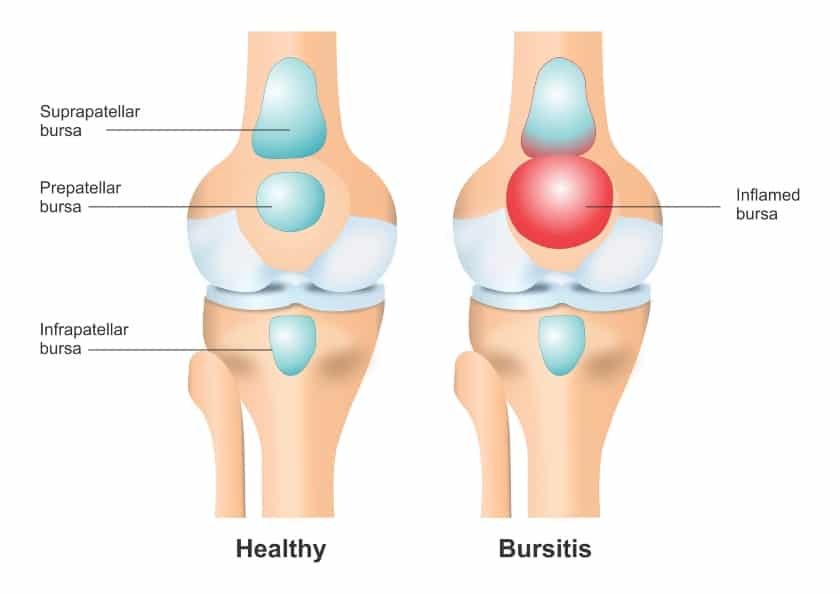
When the fluid-filled bursae sacs around the knee develop inflammation, this can lead to knee pain.
Knee bursitis can also occur as a result of repetitive knee bending activities, creating irritation around the area of the affected bursa.
5. Fracture

A fracture can occur in any of the bony structures that form the knee. Usually, this results from a more obvious trauma, such as a fall or sports injury.
A fracture will usually be more obvious with its symptoms, such as severe knee pain, inflammation, swelling, and an inability to fully bear weight on the leg.
If you have a concern for a knee fracture, this requires immediate medical attention and more serious intervention.
6. Other Possible Causes of Knee Pain
Seeing as the list can go on and on, other common possible causes of knee pain when going down stairs to consider can include the following:
- Patellofemoral pain syndrome (a.k.a. runner’s knee)
- Dislocated knee cap
- Iliotibial band (IT band) syndrome
- Not maintaining a healthy weight (this can place additional stress and loads on the joints)
- Improper shoe wear
- Not maintaining a healthy exercise routine to support the knee structures (this increases your chances of knee pain and/or injury)
- Pain in nearby joints, such as the hip or ankle (this can lead to a compensation injury at the knee)
How to Deal with Knee Pain
When you first begin noticing knee pain (outside of an immediate injury that requires sooner medical attention of course), there are some steps and measures you can take to avoid your pain worsening.
1. R.I.C.E.
Rest, Ice, Compression, Elevation. For treating knee pain temporarily and to initially reduce knee pain, the R.I.C.E. method is very valuable.
Initially after you begin noticing knee pain, one of the best things you can do is allow the knee to rest. Now, don’t become completely sedentary, but do try to avoid activities that tend to aggravate your pain.
Ice is best to use versus heat at first because many times knee pain is accompanied by inflammation and mild swelling. Ice will more effectively treat these issues. Try to avoid icing longer than 20 minutes at a time, and make sure to take at least a half hour break between icing sessions.
Compression involves wrapping or using a knee brace of some sort. Use of compression can greatly help with swelling and pain management.
While you don’t want to necessarily get used to wearing a knee brace all the time long-term (your supportive soft tissues won’t feel the need to work if the brace does it all for them!), for initial pain management and to help you be able to move around more easily while healing, this can be a helpful tool.
As a side note, some find taping the knee to be more beneficial to reduce pain versus using a brace or wrap. There are many taping methods available to help support the knee.
Below you’ll find a video demonstrating a general taping method to help with knee pain. If you’re in physical therapy, make sure to discuss this option with your physical therapist and they can work with you to find the best taping method for your knee pain.
Never underestimate the power of elevating an injured area. For many of the reasons already listed, keeping the knee elevated will further help with management of pain, swelling and inflammation. The knee may feel more comfortable with a large pillow under the entire leg to support it.
2. Weight Management
We mentioned earlier how a person’s body weight can place additional stress on an otherwise healthy knee.
Extra body weight will make the knees bear more of a load than they may be capable of. This will then affect many of your daily activities, including walking, bending, and going up or down stairs.
A healthy body weight can be achieved through a combination of the right diet and exercise routine. If you’re not sure where to start, consult with your doctor for recommendations and other referral sources.
Other healthcare professionals that can assist with your goal of improving your body weight include a dietician or nutritionist for tips on a healthy diet, a personal trainer to help you create and maintain a consistent workout routine, and a physical therapist to assist with an appropriate home exercise program while also addressing and helping to alleviate knee pain.
3. Anti-Inflammatory Medication
Your doctor may recommend for you to take over the counter treatment options, such as anti-inflammatory medications, especially if pain worsens after you’ve already attempted other pain relief interventions.
These can help to reduce pain, swelling and inflammation, all of which are necessary to help you start moving again the right way.
4. Exercises
Exercise deserves its own category, as practicing the right exercise routine not only can help reduce pain when you’re experiencing knee pain, but also can help to prevent knee pain and knee injuries in the first place.
Maintaining the right balance of muscle strength and flexibility is very important for supporting and stabilizing the knee, especially for the task of descending stairs.
While the list of possible exercises can go on and on, we’re going to take a look at a few that will specifically help if you have knee pain going down stairs. A couple of these will actually have you using the stairs during your exercise!
1. Long Arc Quad
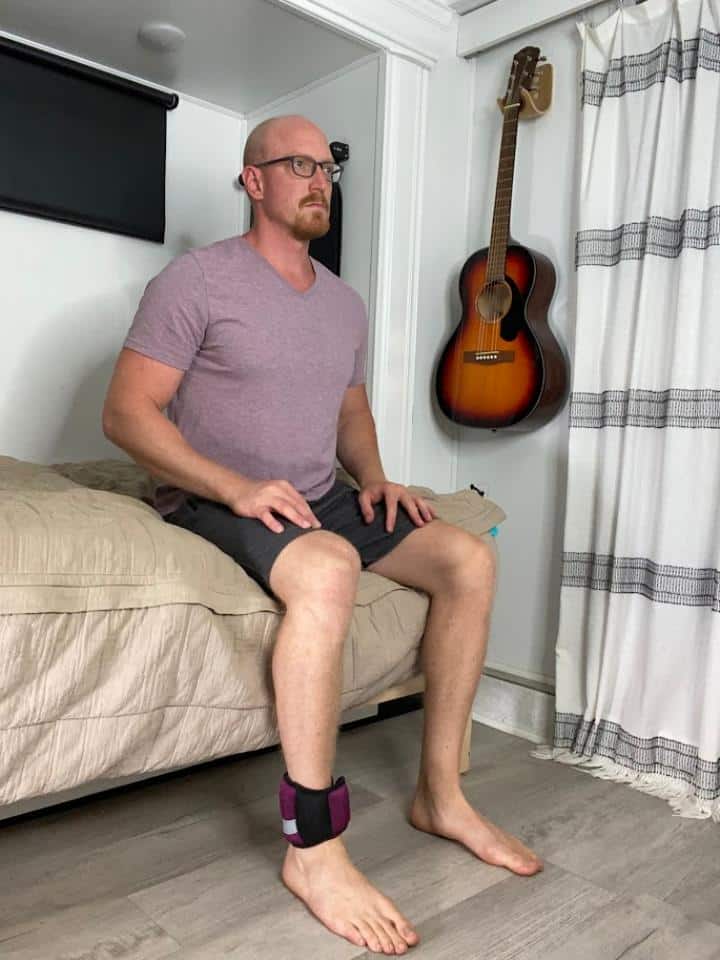
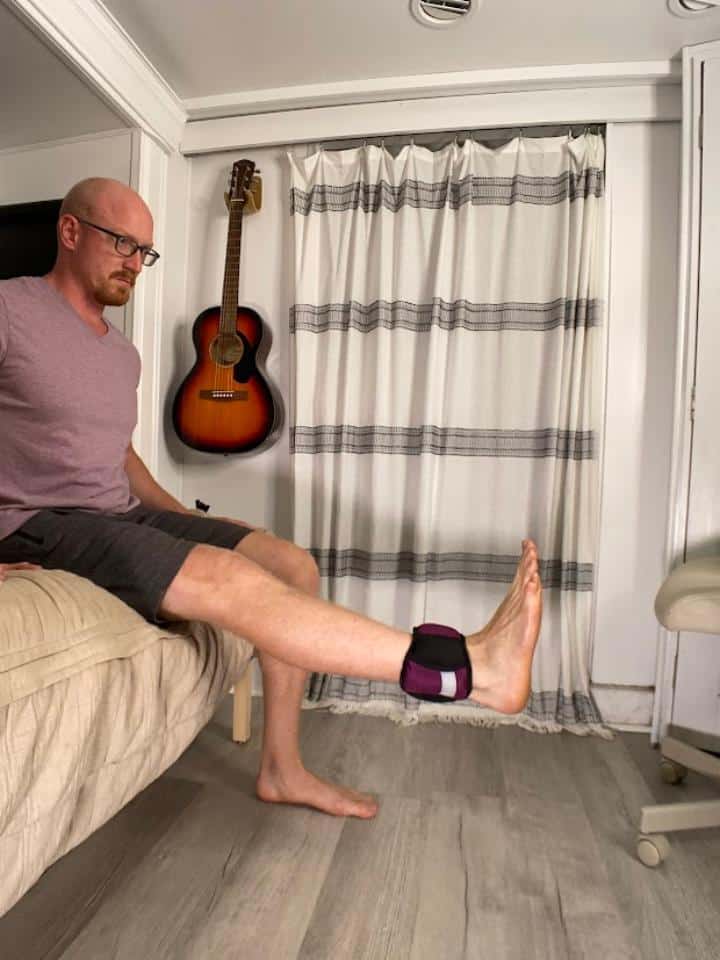
- You’ll be seated for this exercise. You can use a small ankle weight (2-3# to begin with) or a resistance band tied around the ankles (light, medium or heavy resistance).
- While seated nice and tall in a chair, begin with the feet flat on the floor.
- Slowly straighten the working knee, kicking the foot off the floor.
- Hold for 2 seconds, then return to your starting position.
- Repeat 10-15x for 2-3 sets.
2. Wall Squat
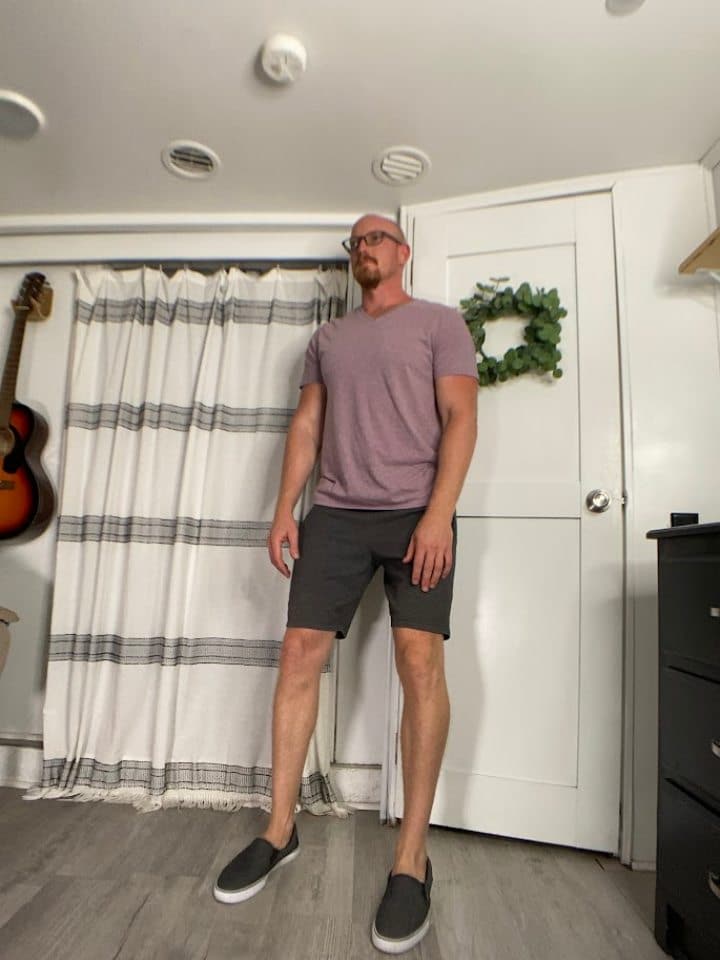
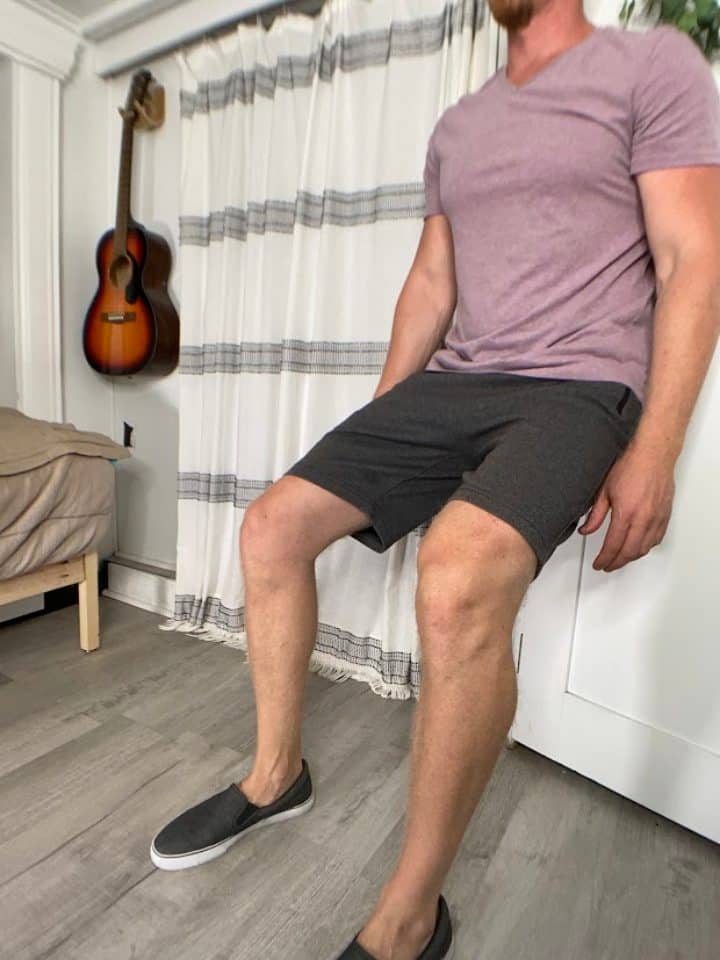
A wall squat is a great alternative to your more traditional squatting form as it really targets the thigh muscles, or quadriceps, and gluteus muscles without aggravating the knees or back.
- You’ll begin with your back flat against a wall.
- While keeping your back flat, walk the feet away from the wall (~2-3 feet) so that you’re completely leaning against it.
- Make sure your feet are about hip width apart.
- Slowly bend your knees and slide down the wall. Hold anywhere from 2-5 seconds, then return to your starting position.
- Repeat 10-15x for 2-3 sets.
Make sure to start small with the depth of your squat. Your knees should never reach past your toes. Generally speaking, avoid bending the knees beyond a 90-degree angle maximum in order to avoid placing excessive compression forces over the front of the knees.
For further clarification, check out this video which will demonstrate the right and wrong way to do a wall squat.
3. Forward Step Up
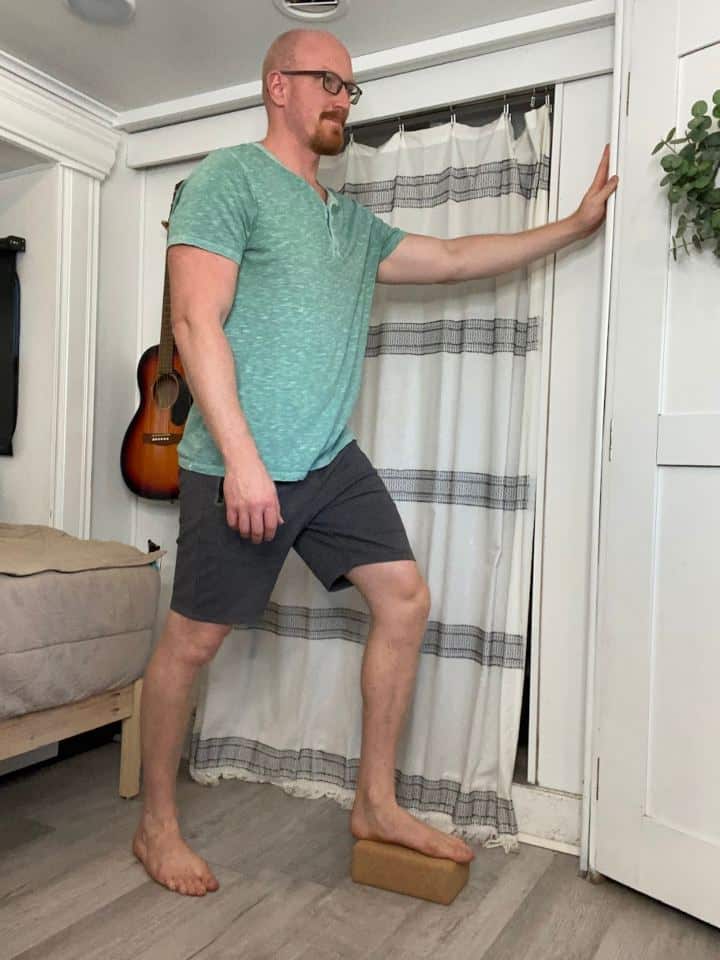
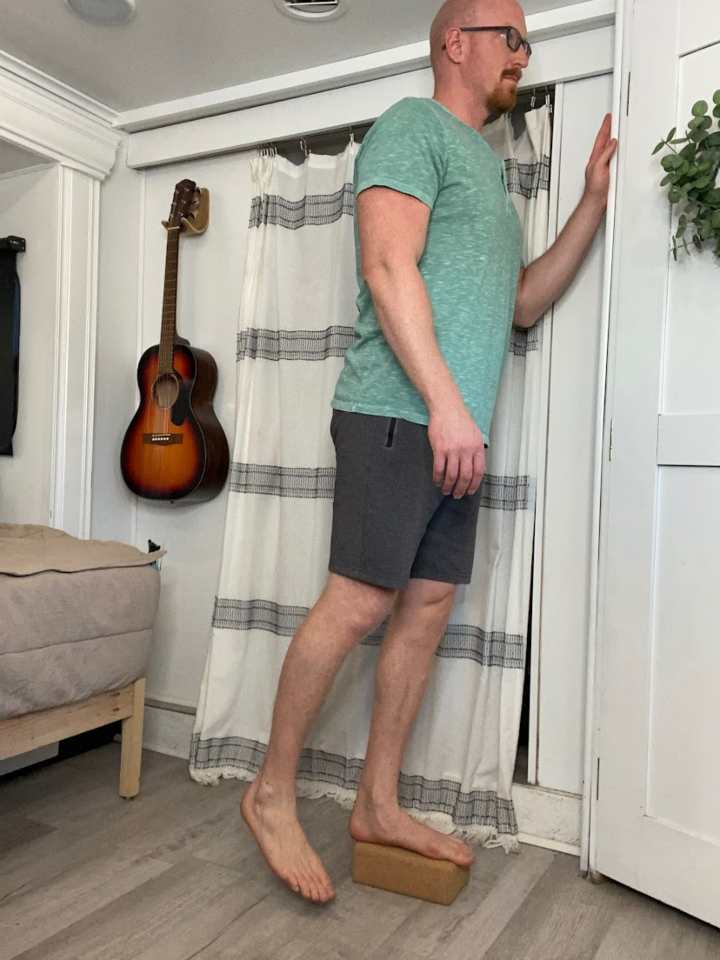
Although going down stairs is the primary problem you may be having with your knee pain, practicing forward step ups on a single step is a great way to practice functional strengthening.
Forward step ups will focus on strengthening the quadriceps and gluteus muscles without making your pain worse if done the right way.
- Using a single step about 4-6 inches high (if you don’t have a step, you can use a firm book as a substitute of equal height), place the foot flat on the step. Make sure the opposite leg is flat on the floor, but within close proximity to the step.
- Ensure the knee and thigh are pointing straight forward. If you have handrails or can position the item you’re using next to your countertop for support, this can be helpful to hold on to.
- When ready, straight the knee and squeeze the glutes to step all the way up on the step, then lower back down. You should end up in the same position you started in.
- Try to go up with a little more of a quick speed, but slow and controlled on the way back down.
- Repeat 10x for 2-3 sets.
4. Lateral Step Up
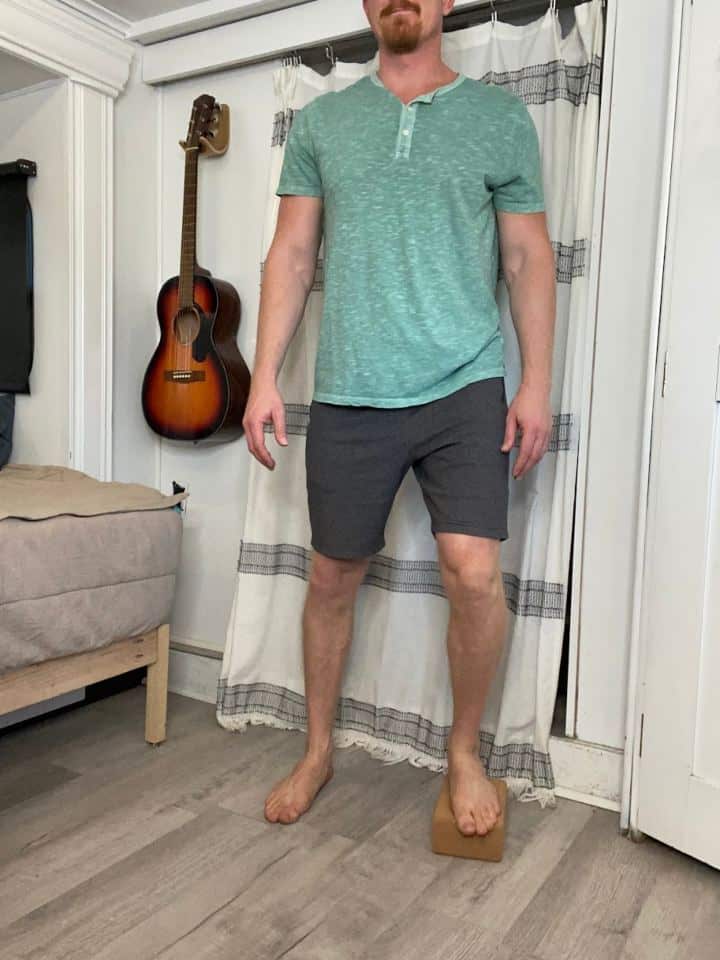
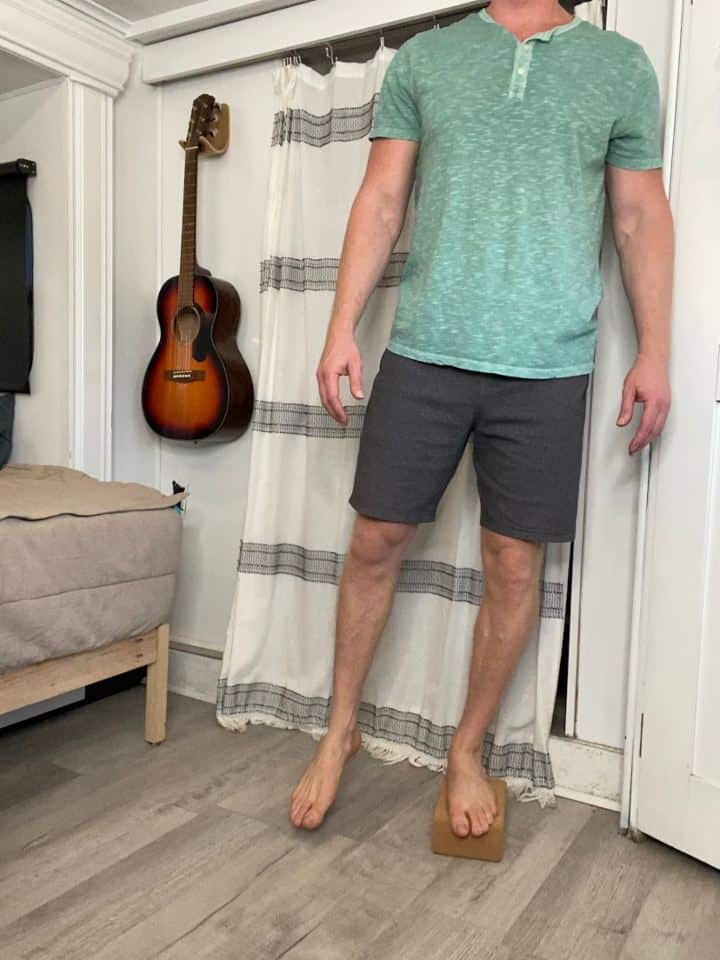
A lateral step upworks the same muscles as a forward step up, but it will target your outer thigh muscles a bit better. These muscles are helpful and necessary for stabilizing the knee.
- Positioning for a lateral step up is very similar as a forward step up, except this time you’ll be positioned sideways next to the step versus forward.
- Once positioned sideways, place the foot closest to the step on the object. Make sure the opposite foot is positioned next to the step, but slightly back. This will help make sure the knee on the step is in proper alignment.
- While keeping the knee and thigh pointed straight forward, step up sideways, or laterally, on the step. Lower back down to your starting position.
- Similar to the forward step up, try to go up with a bit more quickness, but slowly lower down.
- Repeat 10x for 2-3 sets.
Feel free to practice all exercises on both legs. Make sure that no exercise or moving is causing knee pain. If it is, check your form and try to adjust your positioning as able.
You can also reduce the number of repetitions and sets. If you make these changes, and pain continues, then stop the exercise.
Tips on How to Go Down Stairs with Knee Pain
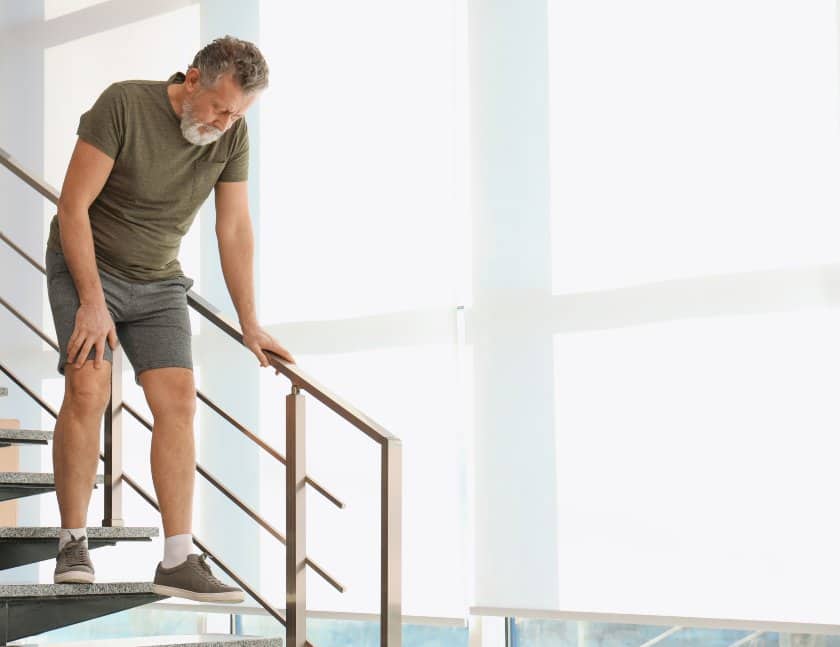
Now that we’ve looked at knee anatomy in relation to knee pain, possible causes of knee pain, and measures that can be taken to help resolve your knee pain, let’s review some tips on the best way to go down stairs.
These tips are meant to help control your pain, prevent increasing pain, and may even help avoid pain altogether.
1. Using Stair Railing
If you have stair railing available, use it to help make going down stairs more pain-free.Long-term, the goal isn’t for you to solely rely on the railing or over-utilize your upper body versus making your lower body do the work when going down stairs; however, for pain management and while re-training your muscles, a little help from stair railing can help provide pain relief.
2. Keep your weight more towards the heel on the leg lowering you down the stairs
While going down stairs, if you simply allow the knee to collapse forward over the toes with every step, this will cause pain, especially in the front of the knee.Instead, try to keep your weight favoring the heel on the standing leg for as long as possible until you have to step down on the front leg.
3. Step Down Slowly
Try to avoid rushing down the stairs.
While it will require a little more effort from your muscles to slowly lower you down each step in a controlled manner, this will more effectively manage your pain. Plus, you’ll encourage your muscles to work and contract the right way, which will be better for your knee in the long run.
4. Keep the Knee Stable
Make sure while going down stairs that you’re encouraging proper alignment and mechanics in the knee.
Avoid allowing the knee and thigh to move side to side, as this will not support the knee joint.
5. Make sure to address any underlying injuries or abnormalities causing your pain
Even with making sure to go down stairs using the right body mechanics and control, ultimately, if you don’t address the underlying issue, your pain will continue.
This is why it’s important to seek advice and a consultation from your doctor and a physical therapist if you’re having persistent knee pain.
Once you’ve addressed and initiated proper treatment for the underlying issue, then using the right body mechanics and control while going down stairs will be more effective.
For a full demonstration of what you should and shouldn’t do when going down the stairs, take a look at the following video.
Take Home Points
Going down stairs doesn’t have to be something you dread!
If you’re having knee pain going down stairs, first and foremost you need to identify what is causing your pain. As mentioned above, consult with your doctor and a physical therapist to help get down to the root of the problem.
There are many techniques available for helping to manage knee pain, such as R.I.C.E., weight management, anti-inflammatories, and the right exercise routine.
Make sure to incorporate these pain management strategies while also applying the tips we talked about above and you’ll be able to tackle going down the stairs in no time!
FAQ:
Should I see a surgeon if I keep having knee pain while going down stairs?
Having knee pain when going down stairs does not automatically mean you need surgical intervention.
You can, however, consult with an orthopedic surgeon for further examination. An orthopedic surgeon who specializes in knees can give a full examination, order any necessary imaging, and make appropriate recommendations for your persisting pain.
Should I avoid using the stairs while I’m having knee pain?
While initially addressing your pain, if you can limit stair use temporarily then this can help your symptoms recover more quickly. If you are not able to avoid use of stairs, such as if they’re in your home, then make sure to follow the tips discussed in this article.
Do I need to keep doing knee exercises once my pain resolves?
Even once your pain resolves, make sure to keep up with your knee exercises ~3-4x/week for a maintenance routine. This will help to avoid pain recurrence and keep your knee as strong and stable as possible.


